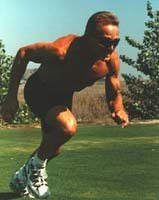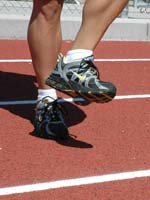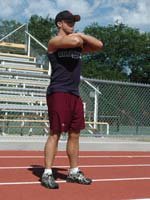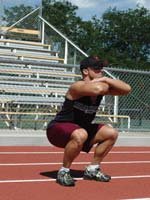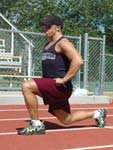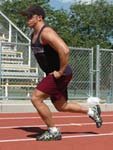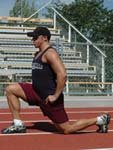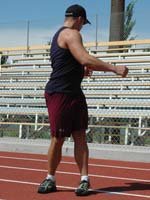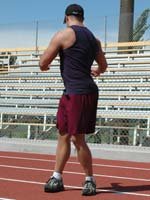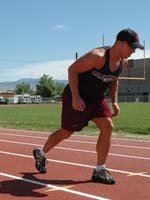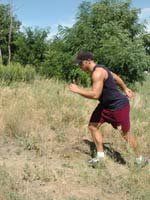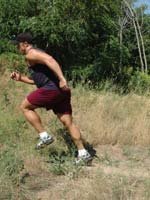Sprinting is by far one of the most fun, effective, and practical methods for improving total body speed and power along with being a very potent stimulus for rapid body composition changes (reduced body fat percentage).
As an extra bonus, if you habitually do most or all of your training inside a gym, you'll be amazed at how fun it can be to train outdoors - you'll actually feel like an athlete! For these reasons, we feel that pretty much everyone should be doing some form of sprints in their training.
Like most powerful training methods however, sprinting can have a down-side: muscle pulls and strains. How many weekend warriors do you know that have pulled their hamstrings playing softball for example, while sprinting to first base? Perhaps you are even one of those weekend warriors yourself!
Since sprinting is such an effective activity, yet is associated with some significant risk, is there a way to ease into it without acquiring any dreaded muscle pulls? Yes there is! The answer lies in HILL SPRINTS.

Your Top 8 List:
Why Hill Sprints Are Superior To Almost Anything You Can Do.
There is a whole host of compelling reasons for incorporating this powerful training method into your overall program. They include:
1. Safety:
Due to the inclined surface, maximum limb speed cannot be attained and thus serves as a safety barrier for your precious hammies! However, in the process, your posterior-chain muscles (low-back, glutes, hamstrings and gastrocs) get an incredible strengthening effect!
2. Technique:
Because of the inclined surface, you are forced to lean forward as you sprint, which teaches you the proper acceleration mechanics that you would want when sprinting on a flat surface. Hill sprints actually become your sprint coach because you almost can't help but do it right!
Hills sprints also teach aggressive arm and shoulder action, which is so critical for maximal acceleration. You simply cannot sprint fast up a hill without deliberate arm action. This helps teach the coordination and little-appreciated upper-body drive needed to sprint effectively on a flat surface.
3. Efficiency:
Hill sprints offer great multitasking potential! You can train, catch a tan, and listen to your favorite tunes (or books on tape if you're learning junkies like we are) while you train.
4. Optimization Of The Force-Velocity Curve:
Powerlifting guru Louie Simmons often uses the following analogy to explain the force-velocity curve: if you try to throw a bowling ball as far as possible, it won't go very far because the mass (read: force) is so great.
If you try to throw a whiffle ball as far as possible, you'll also end up with a short throw because the whiffle ball offers minimal mass to push against. A baseball, on the other hand, can be thrown far because it's a perfect blend of force and velocity.
Keeping this analogy in mind, hill sprints offer similar advantages... in essence; they're basically a "sweet spot" between lifting and sprinting. The best of both worlds.
5. Vanity:
Hill sprints are a great way to dramatically increase the caloric expenditure of an activity that already burns a boatload of calories when performed on flat ground. Again, think of hill sprints as a cross between sprinting and weightlifting. This has amazing benefits on body composition!
The next time you see a major track meet on TV, pay close attention to the short sprinters: they have arguably the greatest physiques on the planet... bodybuilders included.
6. Self-Discipline:
Unlike almost any other form of training, that hill has a way of making you work hard... once you've got your momentum up, you won't want to lose it, so you're actually compelled to maintain or even increase your speed. Again, the hill becomes your coach... you're compelled to work hard and you're compelled to have awesome technique... what other exercise can offer this?!?
| RELATED ARTICLE | ||
|
7. Endorphin Rush:
At the risk of getting all misty-eyed on you, we gotta say, completing a hill has a Rocky-esque feeling of victory (honest!) Many of our clients have reported this experience after performing hills.
8. Functionality:
Lastly, sprinting is, well, functional. A lot of "functional training" guru's constantly push exercise balls and Bosu boards, but we'll place our money in a good program of hill sprints any day of the week.

On Your Marks...
Our preferred approach to getting started would be to perform hill sprints twice per week prior to a full body or lower-body oriented resistance-training workout. If you could sprint in the AM for example and then lift in the PM that would be another option to give you some time to recover in between.
Since a sprint workout has a similar training effect on the body to a resistance training session, you should take similar recovery measures (recovery shake, hot-cold contrast showers, stretching, etc...) for both types of workouts.
 Hill Sprint Workout:
Hill Sprint Workout:
Here's an example of how you might set up your hill sprint workout:
Jog/Stride:
For 1 lap around a track or soccer/football field. However any open area (preferably grass or dirt) will also work. The key is just to warm-up the body and prepare it for a few dynamic stretches and drills.
Dynamic Mobility Drills:
Since most of the force produced to sprint occurs around the joints of the hip, knee, ankle, and shoulder, it is important to quickly loosen up these areas. The following drills should be performed for approximately 10 repetitions (in each direction if applicable) to help physiologically and neurologically prepare the body for the sprints:
- Ankle/foot circles
- Bodyweight squats (helps warm up knees, ankles, and hips)
- Alternating lunges (keep tall spine to stretch out rear hip-flexor)
- Hip rotations (like big Hula-Hoop circles)
- Spine twisters
- Shoulder circles (like swimming, forward and backward)
- Shoulder shrug circles (each direction)
- Jumps in place (progressively higher each one)
Preparatory Sprints:
Next, take a few moments to do 3-5 sprints starting at approximately 50% of what you feel would be your maximum speed for that day. Each sprint, try to go 15-20% faster with walk-back recoveries before starting the next one. The distance for these warm-ups should be approximately 20 yards or meters. The final warm-up should be around 90-95% of your max speed.
The Hill Sprints:
There are so many ways you could set up these workouts, we're just going to give you a very general and basic program to get you started:
- 5 x 10 yards (rest 15 seconds in between)
- 4 x 20 yards (rest 30 seconds in between)
- 3 x 30 yards (rest 60 seconds in between)
- 2 x 40 yards (rest 90 seconds in between)
- 1 x 50 + yards if the hill is long enough
 Click Here For A Printable Log Of This Hill Sprint Routine.
Click Here For A Printable Log Of This Hill Sprint Routine.
This would be a great hill workout to help increase your sprinting ability while preserving the health of your muscles due to the shorter distances. Remember, the emphasis here is on quality (which is why there are increasing rest periods with each new distance).
Of course, your volume could (and should) be reduced if you are a true newbie to sprinting. Over time the distances can slowly be increased or the rest intervals decreased to create on overload effect. Be prepared for some serious posterior chain development as well as a beefier, leaner physique for the upcoming summer months.
We sincerely hope that we've provided valuable concepts for you in this article, and look forward to hearing about your experiences with hills sprints!
| Additional Hill Sprint Tips & Tricks: | |
|
About The Authors:
Charles Staley, B.Sc., MSS: His colleagues call him an iconoclast, a visionary, a rule-breaker. His clients call him "The Secret Weapon" for his ability to see what other coaches miss. Charles calls himself a "geek" who struggled in Phys Ed throughout school. Whatever you call him, Charles' methods are ahead of their time and quickly produce serious results. His counter-intuitive approach and self-effacing demeanor have lead to appearances on NBC's The TODAY Show and The CBS Early Show. Sign-up for Charles' free online newsletter at www.StaleyTraining.com. You'll get a kick out of it - really!
Keats Snideman, B.S. CSCS, LMT, NMT currently serves as Technical Content Director for Staley Training Systems. As a competitive sub-masters sprinter (100 & 200m dashes), Keats specializes in the enhancement of athletic fitness, including improvements in speed, explosive-strength and dynamic flexibility. He has coached and given treatment to a variety of clients, including athletes from the NFL, NBA, MLBA, USA Track & Field as well as athletes from both the collegiate and high school levels.

